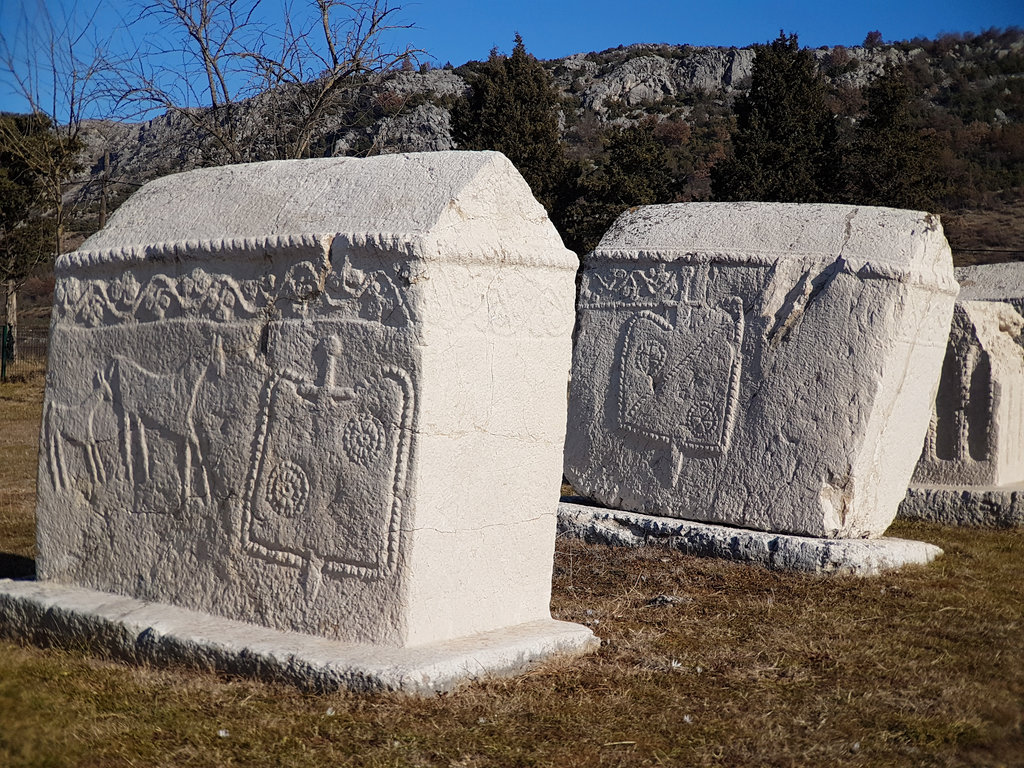A. Sutherland – AncientPages.com – Enigmatic Stecci, the tombstones, often referred to as stone sleepers, are one of the oldest witnesses of Bosnia and Herzegovina history.
They are considered the region’s most legendary symbol. A single tombstone or collections of monoliths are scattered throughout the entire territory of the present Bosnia and Herzegovina, as well as in parts of Croatia, Serbia, and Montenegro.
Sir Arthur John Evans, an English archaeologist, and pioneer in the study of Aegean civilization in the Bronze Age described some stecci during his travels through Bosnia and Herzegovina in 1875.
‘Stecci’ probably appeared in the second half of the 12th century, with the first phase lasting throughout the 13th century. A period of the most intensive production and use of this kind of decoration is dated to the 14th and 15th centuries but in the 16th century, the use of stecci completely ceased.
There are about 70,000 medieval stecci tombstones recorded at 3,300 odd sites, about 60,000 monuments are located in Bosnia and Herzegovina, 4,400 in Croatia, 3,500 in Montenegro, and 4,100 in Serbia.
Based on historical records, the oldest mention of stecci dates back to 1530 and comes from the notes of the 16th-century diplomat Benedict Curipeschitz, who traveled to Constantinople.

Stecci in Radimlja necropolis. source
Later, Sir Arthur John Evans, an English archaeologist, and pioneer in the study of Aegean civilization in the Bronze Age described some stecci during his travels through Bosnia and Herzegovina in 1875. Evans, who referred to them as “mysterious tombstones”, suggested that they belonged to medieval Bogomil heretics and their tradition in the Balkans.bosnia
Another theory proposes that stecci are related to Vlach people, who originated from either the Dacians or the Thracians along the Danube.
These stone slabs are sometimes as heavy as 30,000 kilograms and on average, they are two meters long and one meter wide. The slates are between 30 and 50 centimeters high and the sarcophagi and tombs are about 1.5 meters in height. The height of the pillars ranges from two to three meters.
Often carved in bas-relief, stecci are found in many different shapes. Many of them are horizontal monoliths, commonly shaped like chests, while others are gable-roofed sarcophagi. Yet others are more simple slabs or upright stelae or pillars, with the occasional massive cross or another form.

Ancient epitaphs on stecci or enigmatic, difficult to understand inscriptions recorded in the Bosnian Cyrillic alphabet, contain messages from the past, which remain undeciphered. Credits: Bosniafacts
In his book “Homeric Whispers: Intimations of Orthodoxy in the Iliad and Odyssey”, Roberto Salinas Price describes an interesting place known as the Palace of Priam also known as the Sanctuary of Apollo and the (once) intact oval platform of a megalithic observatory with its major axis aligned east-west. … Up until some decades ago (mid-20th century) there were twelve Bogomil stecci – large limestone blocks, almost always hewn into the shape of a V-roofed house, surrounding the chapel..”
In the center is the small chapel of Sveti Stephan, one of the most magnificent Medieval churches constructed in the historic city of Nesebur. The description of this sanctuary as the Palace of Priam… is as follows:
“the beauteous palace of Priam, adorned with polished sun halls and in it were fifty chambers of polished stone, built each hard by the other; therein the sons of Priam were wont to sleep beside their wedded wives, and for his daughters over against them on the opposite site within the court were twelve roofed chambers of polished stone, built each hard by the other; therein slept Priam’s sons-in-law beside their chaste wives….”
The “polished sun halls…” is a reference to the area between an outer and inner ring of stones aligned in such a manner as to fix a set of points on the horizon (sunrises and sunsets)…”
‘Stecci’ probably appeared in the second half of the 12th century, with the first phase lasting throughout the 13th century. A period of the most intensive production and decoration were the 14th and 15th centuries. In the 16th century, their use completely ceased.
The monolithic stecci are richly decorated with animals, spirals, floral motifs, crosses, fleurs-de-lis, scenes of dancing, hunting and battles, bunches of grapes, and ancient symbols including stars, crescent moons, and suns. Ancient epitaphs on stecci or enigmatic, difficult to understand inscriptions recorded in the Bosnian Cyrillic alphabet, contain messages from the past, which remain undeciphered.
Especially interesting are the large human figures, often described as ‘ducal’, dressed in tunics, with one arm raised and palm open or flanked by two children. There are also many different theories regarding the meaning of the decorations on the tombstones.
There are also many different theories regarding the meaning of the decorations on the tombstones. Is their origin in Bogomil tradition or do they represent Vlach symbolism, often suggested by several scholars? Could they be related to pagan or Christian beliefs?
Without a doubt, stecci represents a unique phenomenon. They have been studied for more than a century and several thousands of them have been found in different locations of the Western Balkans. However, many questions regarding their true origin and purpose still remain. The ethnic identity of the stecci remains an open subject to discussion. Until now, the most dominant, but still not fully accepted, theory associates them with the autochthonous Vlach communities in the Balkan regions.
However, opponents of this theory consider that their demographic number was too small, were profane and isolated, argue that the Vlachs did not build them from the fall of the Western Roman Empire,or that mythological symbols are related to Old Slavic rather than “Vlach” pagan beliefs.
These megalithic monuments exist, many of them have been registered but they remain unexcavated.
Written by – A. Sutherland – AncientPages.com Senior Staff Writer
Copyright © AncientPages.com All rights reserved. This material may not be published, broadcast, rewritten or redistributed in whole or part without the express written permission of AncientPages.com





